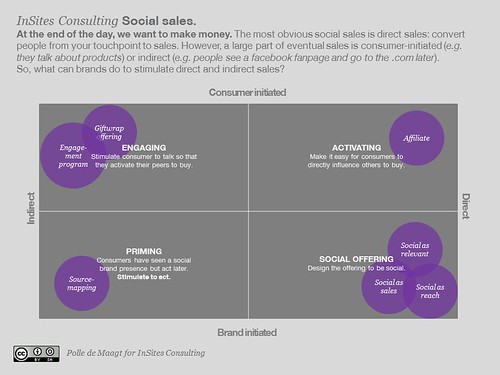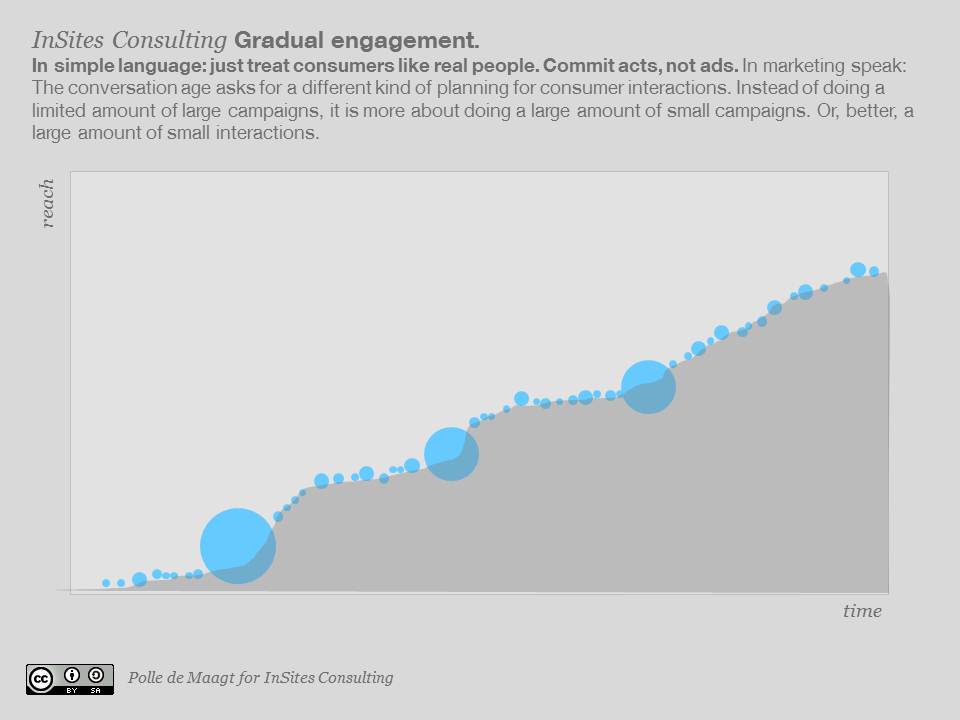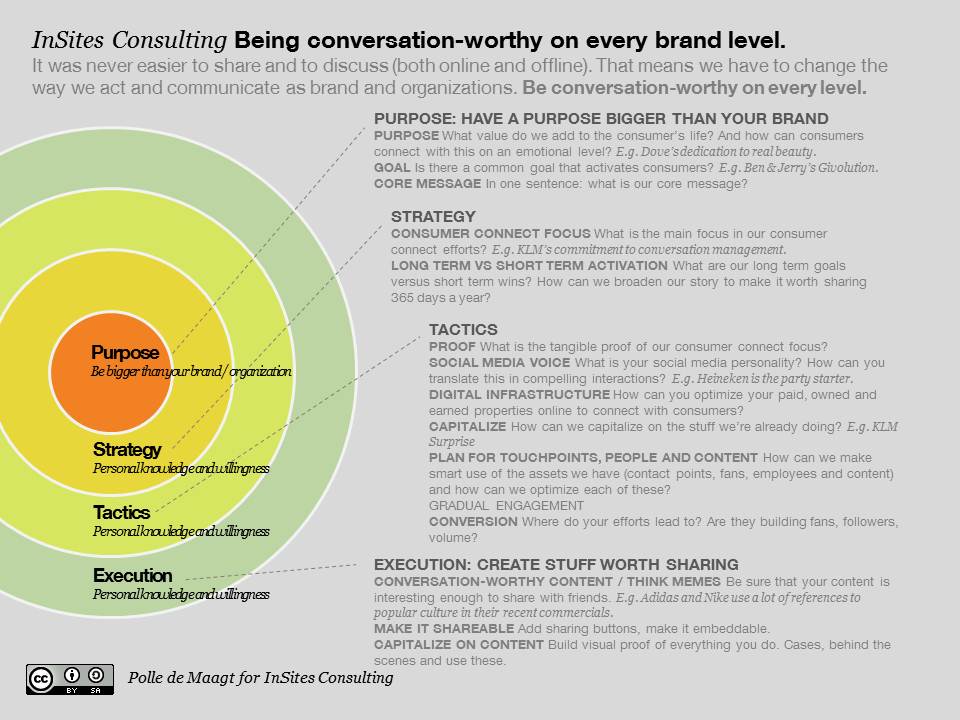So, what will social media do for my sales?
Some hardcore sales people will approach social media merely as a 2.0 version of their mailing lists: let’s build a huge database of Facebook likes and/or Twitter followers and spam them with discounts. Some social media idealists and evangelists approach social media sales or ROI as a forbidden word/discussion. In their opinion, relations and conversations eventually lead to better contact and better sales.
I tend to agree with both. And even with some others.
Some approaches to social sales are more tangible and direct than others. It is easy to measure what clickthroughs bring in terms of sales. It is more difficult to measure what volume and sentiment of conversations bring. Even measuring Net Promoter Score isn’t so obvious (and requires a special action of the consumer to rate the brand). That is why we mapped social sales on two axes: Direct versus indirect and brand initiated versus consumer initiated.
That gives us four quadrants:
- Social offering (brand initiated and direct) Most directly linked to sales and easiest to measure direct impact. Direct clickthroughs from social media efforts: clicks from Facebook or twitter, orders from a mobile app, etc. Design your sales offering to use the social infrastructure:
- Approaching social media as a reach instrument E.g. collecting as many Facebook or Twitter fans and approach it as a mailing list 2.0, like the Dell Outlet twitter account.
- Using social media for ‘social as sales’, only selling when consumers buy together. E.g. daily deal sites like Groupon or a offering like ‘buy 2 together with a friend, get 1 for free’.
- Using available social media data to offer relevance E.g. targetted advertising within Facebook, re-messaging or retargetting campaigns.
- Priming (brand initiated and indirect) People who engage with a brand on, for example, a Facebook fan page and don’t click directly, but return later. A lot of consumers will browse sites, facebook, twitter and other platforms to finally make the sale via direct traffic to the site (typing philips.com) or Google. That would normally mean that Google and direct traffic would be valued ‘too high’ while Facebook and other social platforms would be valued ‘too low’. Conversion attribution would solve this problem for the largest part and will help to give a more ‘honest’ representation of how social and conversations help to generate sales. For more, read my article on conversion attribution and social sales.
- Activating (consumer initiated and direct) Easy to measure, but initiated by consumers. A consumer talks about the brand and activate others directly to buy a product E.g. an affiliate link, a link to a specific discount or shares the product he/she just ordered.
- Engaging(consumer initiated and indirect) This is the most vague and idealistic one. There is much indirect proof that positive word of mouth leads to sales. However, it is really hard to prove exactly what that effect is. A consumer talks about a brand, shares content but doesn’t add a direct call to action. Just ‘normal’ chatter that influences peers, but hasn’t a direct link to sales.
- Engagement program Have a clear program to fuel conversations and make consumers more and more engaged. Have a look at our conversations / engagement funnel.
- Gift-wrap your sales offering Don’t use sales promotion as mere sales promotion. Use your sales promotion to drive brand and conversations. Construct your sales promotions in a smart and converting way. More background and examples in this post.




8 comments
I’m more on the side with those who describe the new buying decision journey as Stimulus, Research, Point of Sale, Experience. Following this decision flow allows your social media and advertising efforts to be influential at every step.
Thanks! I am TOTALLY with you, although I personally prefer McKinsey’s consumer decision journey (slightly modified example here http://www.slideshare.net/polledemaagt/use-your-unused-potential-how-most-insurance-companies-do-great-stuff-but-forget-to-reap-the-rewards-for-ohra/33).
That means you can plot social media/marketing/advertising efforts on either ‘your’ buying decision journey or on the McKinsey decision journey, whatever you prefer.
Implementing this and structuring this in a company is another thing. When companies try to implement social media/marketing/advertising efforts on top of these journeys, they often have a limited approach.
Many companies EITHER approach social sales from either a ‘conversations’ stance (indirect en consumer initiated) OR from a direct and brand initiated approach. I hope that this quadrant/framework helps companies to realize there is more social sales than pure positive conversations or using social media as reach.
You can then, of course, use these different kinds of social sales techniques within the consumer journey.
Does this answer your question?
Great post. What if we would replace “sale” by “application”? Can we then use this model for recruitment?
Absolutely. My point is there are indirect and direct ways and consumer-driven and brand-driven ways of capturing this.
Great post, thanks Polle. Will start up online marketing at new employer soon. Guess it will be a balancing act between sales/conversion and brand/conversation but also between investments and direct ROI.
Totally like customer journey mapping, buying personas and integration of online and social.
Will look into conversion attribution and gift-wrapping.
@twitter-89276202:disqus Selling is easier when you have a great product. So try to measure the NPS of your employees. How many would recommend your company as an employer to friends and family? If it’s good, don’t worry, go social; otherwise it’s a daring effort…
Thank you for the reply. I think McKinsey gets it correct by placing the consumer outside of the funnel but fails by not making a stronger connections between postpurchase experience and consumer driven marketing as well as the affect company driven marketing can have over the entire journey. Which brings us back to the key question of measurement of company driven marketing as it influences the entire process. My answer may seem naive but, you measure where you can and search for data implied connections where you can’t. The consumer is cross session, cross site, multi tabbed, multi device with some purchase decisions being made over multiple months, making it almost impossible to accurately track. I find it refreshing to see so many people trying to tackle this problem. Recently, ComScore developed a new measurement called the SmartLift Attribution Model, with goals of measuring beyond the click. Have you seen this? What do think about this model being converted for use with social media?
Thanks for your elaboration!
I totally agree, it’s the Holy Grail everyone’s looking for 🙂
The SmartLift Attribution Model is just plain conversion attribution, right? I talked about that in a previous post http://www.polledemaagt.com/blog/social-sales-and-proving-the-value-of-conversations-conversion-attribution/ For me, that’s a more indirect and brand-driven way (bottom left quadrant) to prove the value of social media for sales. It is a necessary tool to prove the value of social media, but just one of the tools for me.
E.g. Using social media as pure reach (mailinglist 2.0) is another one.
Trying to prove the value of positive conversations is yet another (although difficult) one.
Personally I think social networks are more and more being used for promotion and spamming.
Its getting harder to put yourself on the map and show yourself between all the rubbish online.
I dont think sales will go up at once but maybe in the long run, your brandname will grow and so will your earnings.